The Honda XR series is a range of four-stroke off-road motorcycles that were designed in Japan but assembled all over the world.

The Honda Shadow refers to a family of cruiser-type motorcycles made by Honda since 1983. The Shadow line features motorcycles with a liquid-cooled 45 or 52-degree V-twin engine ranging from 125 to 1,100 cc engine displacement. The 250 cc Honda Rebel is associated with the Shadow line in certain markets.

The Honda CX series motorcycles, including the GL500 and GL650 Silver Wing variants, were developed and released by Honda in the late 1970s, with production ending in most markets by the mid 1980s. The design included innovative features and technologies that were uncommon or unused at the time such as liquid cooling, electric-only starting, low-maintenance shaft drive, modular wheels, and dual CV-type carburetors that were tuned for reduced emissions. The electronic ignition system was separate from the rest of the electrical system, but the motorcycle could only be started via the start button.
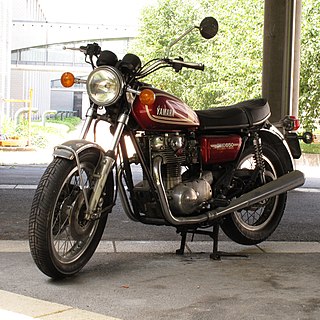
The Yamaha XS650 is a mid-size motorcycle that was made by the Yamaha Motor Company. The standard model was introduced in October 1969, and produced until 1979. The "Special" cruiser model was introduced in 1978 and produced until 1985. The XS650 began with the 1955 Hosk SOHC 500 twin. After about 10 years of producing 500 twin, Hosk engineers designed a 650 cc twin. Later Showa Corporation acquired the Hosk company, and in 1960 Yamaha acquired Showa, with Hosk's early design of 650 cc twin.

A motorcycle engine is an engine that powers a motorcycle. Motorcycle engines are typically two-stroke or four-stroke internal combustion engines, but other engine types, such as Wankels and electric motors, have been used.
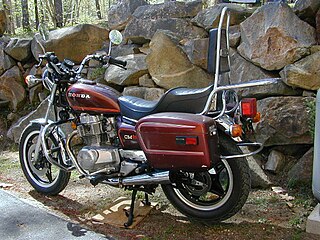
The Honda CM400 is a street bike produced by the Honda Motor Company from 1979 to 1982, part of a series of motorcycles with the prefix 'CM' using various engine capacities. It was a precursor to the Honda Rebel series of motorcycles. It was equipped with electric start and electronic ignition. Models included the CM400A, CM400C (Custom), CM400E (Economy) and CM400T (Touring). The CM400C was produced only in 1981, making it one of the rarer models.
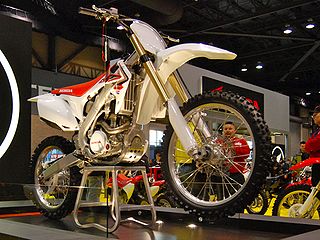
The Honda CRF series is a line of four-stroke motocross, trail, and dual sport motorcycles manufactured and marketed by Honda.

The Honda CL450 was the dual sport or "scrambler" model of Honda's 450 cc (27 cu in) DOHC parallel-twin engined motorcycle. It was the sister bike to the Honda CB450.

The Harley-Davidson Sportster is a line of motorcycles produced continuously since 1957 by Harley-Davidson. Sportster models are designated in Harley-Davidson's product code by beginning with "XL". In 1952, the predecessors to the Sportster, the Model K Sport and Sport Solo motorcycles, were introduced. These models K, KK, KH, and KHK of 1952 to 1956 had a sidevalve engine, whereas the later XL Sportster models use an overhead valve engine. The first Sportster in 1957 had many of the same features of the KH including the frame, fenders, large gas tank and front suspension.

The Honda CB175 is a standard motorcycle made by Honda from 1969 to 1973. It had a 174 cc (10.6 cu in) four-stroke, straight-twin engine with a single overhead camshaft, two valves per cylinder, dual slide-valve carburetors, and dual exhausts. It was also equipped with a five-speed gearbox, 12-volt electrics, kick and electric start, front and rear drum brakes, turn signals, speedometer with trip meter, and tachometer, and was rated at 20 bhp (15 kW). An update in 1972, brought a more rounded gas tank and changes to the air box covers, along with some other minor trim changes. The CB175 was discontinued for 1974 and replaced by the CB200, a similar bike already in production. Although not technologically remarkable, Honda's small twins of the 1960s and 1970s were among their best sellers. Dual sport scrambler CL175, SL175 enduro style and touring CD175/CA175 versions were also produced.

The Triumph Bonneville is a standard motorcycle featuring a parallel-twin four-stroke engine and manufactured in three generations over three separate production runs.
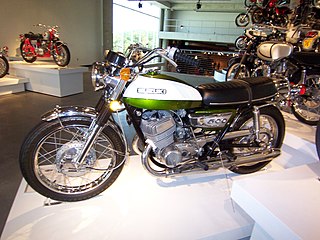
The Suzuki T series was a series of motorcycle manufactured by Suzuki that ran from approximately 1963 through 1977 in various engine displacements between 90 and 500 cc.
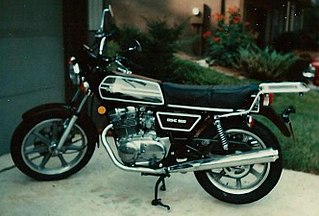
The Yamaha TX500 is a two-cylinder standard motorcycle built by Yamaha and sold in 1973 and 1974. Early models closely resembled the Triumph Bonneville in style. In 1975 the bike was renamed XS500 and then continued to be updated until 1978 when sales ended in the USA. In Europe, the model was available through 1980.

The Honda CM450A is a motorcycle made by Honda in 1982 and 1983. It was based on the CB400 and CM400 models (1978–1981), especially the CM400A Hondamatic (1980–1981). It had a 447 cc (27.3 cu in) SOHC parallel twin engine with two carburetors and a two-speed transmission with a torque converter. It was not a full automatic, however, because the rider had to manually shift between low and high. It is called automatic because there is no clutch required due to the torque converter, and shared the Hondamatic trade name with Honda cars that had true automatic transmissions. The chain-driven CM450A had a top speed of 90 miles per hour (140 km/h) and weighed 413 pounds (187 kg). Both models had a front disc brake and a rear drum brake. The suspension consisted of two shock absorbers at the rear and telescoping shock-absorbing front forks. The fuel tank had a 3.4 US gallons capacity. The exhaust was routed through a separate pipe and baffle on each side of the motorcycle, although both exhaust pipes shared a plenum under the motor. It had an electric start with a kick start as well.

The Honda VFR1200F is the 7th generation Honda sport touring motorcycle from the VF and VFR line motorcycles powered by a transverse mounted V4 engine. The VFR1200F has several new technologies including the first dual clutch transmission offered on a motorcycle.

The Honda CB400T is a range of motorcycles built by Honda. In the United Kingdom it was known as the Dream, whereas in the United States it was known as the Hawk. A Honda CB250T version was also available in some markets including the UK and Australia for licensing reasons.

The Honda NC700 series is a family of motorcycles produced by Honda since 2012. NC700 series was a 'new concept', being unlike conventional motorcycles, a bike designed for commuters, new or veteran riders. The series also includes the motorcycle/scooter hybrid NC700D Integra. The NC700 series is classed as a commuter model bike which has incorporated design and mechanical elements from various motorcycle types. The riding position is similar to standard bike styles. There is a helmet-sized internal storage in place of the traditional fuel tank, which in turn is located under the seat. The series is often marketed as fun to ride, easy to handle and very fuel efficient.
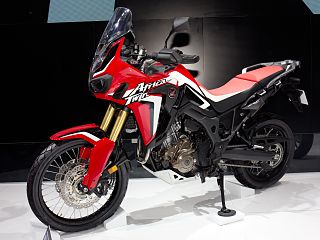
The CRF1000L is a 998 cc (60.9 cu in) 270° crank, parallel-twin dual-sport that revived the Africa Twin name for the 2016 model year. It became available in the UK in late 2015 and early 2016 in the US. It was developed as a modern interpretation of its predecessors, the XRV 750 and Honda XRV650, based on the NXR-750 which won the Paris-Dakar rally four times in the late 1980s. The original V-twin Africa Twin was first sold in Europe from 1988 to the final production year of 2003 but was never brought to the United States. The CRF1000L has also been seen as a response by Honda to the heavier on road focused adventure touring motorcycles such as the BMW R1200GS, Ducati Multistrada, and Triumph Tiger Explorer with a lighter more off-road focused machine.

Bridgestone motorcycles were a division of the Bridgestone Tire Co. of Kyōbashi, Tokyo, Japan that produced mopeds and motorcycles from 1952 to 1970. Initially producing power assisted bicycles, the division moved on to producing mopeds and then motorcycles. The motorcycles were technologically advanced and powered by two-stroke engines. The high technical specification resulted in the machines being more expensive compared to other manufacturers models. Production was stopped in 1970 to protect the supply of tyres to other manufacturers.

The G450X is an Enduro-class motorcycle that was produced by BMW Motorrad between 2008 and 2011.




















